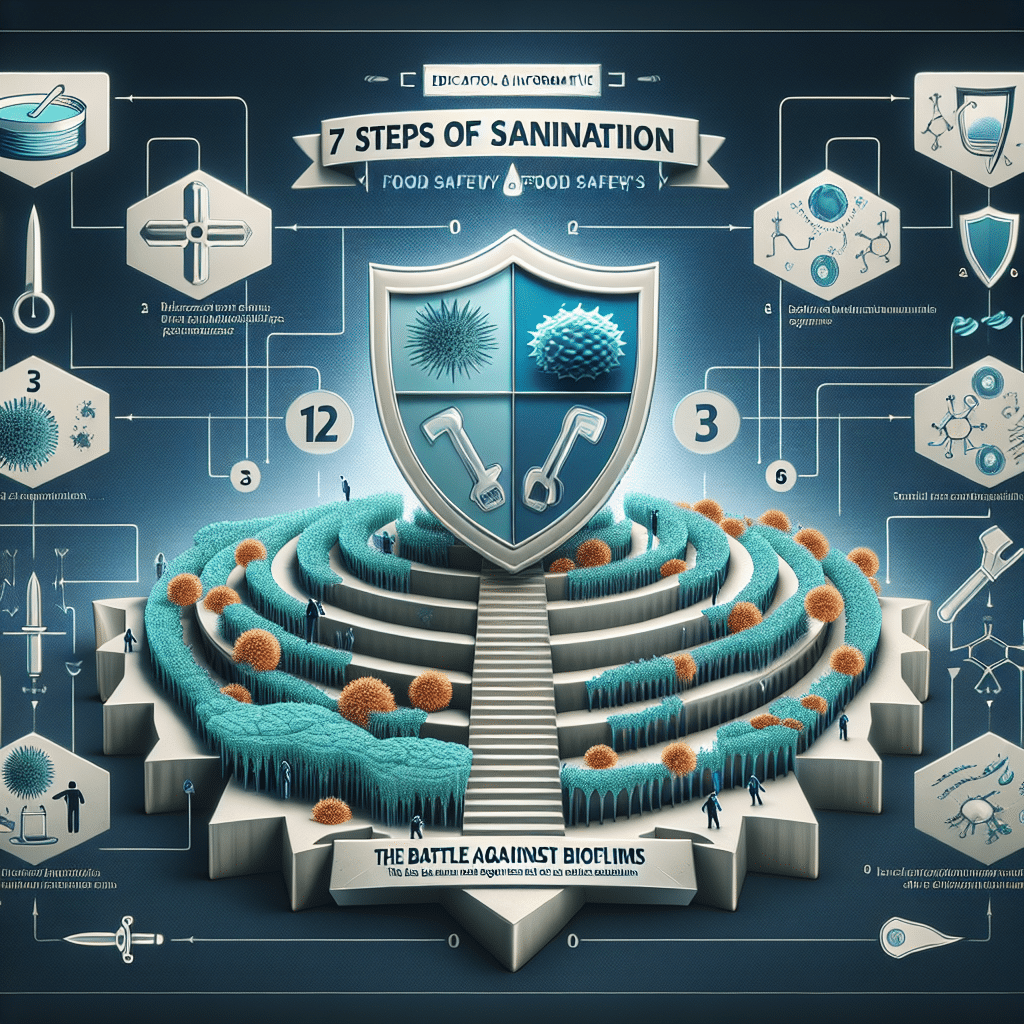Food Safety: Battling Biofilms with the 7 Steps of Sanitation
-
Table of Contents
- Food Safety: Tackling Biofilms with Effective Sanitation Strategies
- Understanding Biofilms and Their Threat to Food Safety
- The 7 Steps of Sanitation to Combat Biofilms
- Step 1: Dry Cleaning and Pre-Rinse
- Step 2: Cleaning
- Step 3: Post-Rinse
- Step 4: Inspection
- Step 5: Disinfection
- Step 6: Final Rinse (if required)
- Step 7: Documentation and Verification
- Challenges and Innovations in Biofilm Control
- Conclusion: The Importance of Rigorous Sanitation in Food Safety
- ETprotein: Enhancing Food Safety with High-Quality Protein Products
Food Safety: Tackling Biofilms with Effective Sanitation Strategies

Food safety is a critical concern for consumers, food manufacturers, and public health officials alike. One of the most challenging aspects of maintaining food safety is the prevention and removal of biofilms in food processing environments. Biofilms are complex communities of microorganisms that adhere to surfaces and are protected by a self-produced matrix. They can harbor pathogens such as Listeria, E. coli, and Salmonella, which pose significant health risks. To combat these resilient structures, the food industry employs rigorous sanitation protocols. This article will explore the seven steps of sanitation that are essential in battling biofilms and ensuring food safety.
Understanding Biofilms and Their Threat to Food Safety
Biofilms are not just a slimy nuisance; they are formidable opponents in the realm of food safety. These microbial cities can form on various surfaces, including stainless steel, plastic, and glass, commonly found in food processing facilities. Once established, biofilms are difficult to eradicate and can lead to persistent contamination, product recalls, and outbreaks of foodborne illness. According to the Centers for Disease Control and Prevention (CDC), biofilms are responsible for a significant number of bacterial infections in the United States, emphasizing the need for effective sanitation measures.
The 7 Steps of Sanitation to Combat Biofilms
Implementing a thorough sanitation program is crucial for the control of biofilms. The following seven steps provide a systematic approach to ensure a clean and safe food processing environment:
Step 1: Dry Cleaning and Pre-Rinse
- Remove large debris and food residues from surfaces.
- Conduct a pre-rinse with water to soften and remove loose soils.
Step 2: Cleaning
- Apply detergents or cleaning agents to break down fats, proteins, and carbohydrates.
- Use mechanical action, such as scrubbing, to enhance the effectiveness of cleaners.
Step 3: Post-Rinse
- Rinse off the cleaning agents along with the dislodged biofilm components.
- Ensure that no residue remains, as it can interfere with the disinfection process.
Step 4: Inspection
- Conduct a thorough visual inspection for any remaining soils or biofilm traces.
- Use ATP (adenosine triphosphate) testing to detect any organic matter that is not visible to the naked eye.
Step 5: Disinfection
- Apply disinfectants to kill any remaining microorganisms.
- Choose the appropriate disinfectant based on the type of microorganisms present and the surface material.
Step 6: Final Rinse (if required)
- Rinse surfaces with water if the disinfectant used requires it.
- Ensure that no disinfectant residue remains, as it can be toxic if ingested.
Step 7: Documentation and Verification
- Keep detailed records of the sanitation process for accountability and traceability.
- Verify the effectiveness of the sanitation program through microbial testing and environmental monitoring.
Challenges and Innovations in Biofilm Control
Despite the established sanitation steps, biofilms remain a formidable challenge due to their resistance to conventional cleaning methods. Innovations in sanitation technology, such as enzyme-based cleaners and bacteriophages, are being explored to enhance biofilm removal. Additionally, the integration of Hazard Analysis and Critical Control Points (HACCP) and Good Manufacturing Practices (GMP) can further strengthen food safety protocols.
Conclusion: The Importance of Rigorous Sanitation in Food Safety
The battle against biofilms is ongoing, but with the implementation of the seven steps of sanitation, the food industry can significantly reduce the risks associated with these microbial communities. It is essential for food processing facilities to remain vigilant, continuously update their sanitation practices, and adopt new technologies to ensure the highest standards of food safety.
ETprotein: Enhancing Food Safety with High-Quality Protein Products
In addition to rigorous sanitation practices, the use of high-quality ingredients is vital for food safety and quality. ETprotein is a company that stands out for its commitment to providing top-tier protein products that meet the stringent requirements of the food industry. Their range of organic and non-GMO proteins, including rice, pea, and various seed proteins, are ideal for manufacturers who prioritize safety and quality. Moreover, ETprotein’s L-(+)-Ergothioneine (EGT) products offer additional benefits for food preservation and shelf-life extension, contributing to safer and more stable food products.
About ETprotein:
ETprotein, a reputable protein and L-(+)-Ergothioneine (EGT) Chinese factory manufacturer and supplier, is renowned for producing, stocking, exporting, and delivering the highest quality organic bulk vegan proteins and L-(+)-Ergothioneine. They include Organic rice protein, clear rice protein, pea protein, clear pea protein, watermelon seed protein, pumpkin seed protein, sunflower seed protein, mung bean protein, peanut protein, and L-(+)-Ergothioneine EGT Pharmaceutical grade, L-(+)-Ergothioneine EGT food grade, L-(+)-Ergothioneine EGT cosmetic grade, L-(+)-Ergothioneine EGT reference grade and L-(+)-Ergothioneine EGT standard. Their offerings, characterized by a neutral taste, non-GMO, allergen-free attributes, with L-(+)-Ergothioneine purity over 98%, 99%, cater to a diverse range of industries. They serve nutraceutical, pharmaceutical, cosmeceutical, veterinary, as well as food and beverage finished product distributors, traders, and manufacturers across Europe, USA, Canada, Australia, Thailand, Japan, Korea, Brazil, and Chile, among others.
ETprotein specialization includes exporting and delivering tailor-made protein powder and finished nutritional supplements. Their extensive product range covers sectors like Food and Beverage, Sports Nutrition, Weight Management, Dietary Supplements, Health and Wellness Products, and Infant Formula, ensuring comprehensive solutions to meet all your protein needs.
As a trusted company by leading global food and beverage brands and Fortune 500 companies, ETprotein reinforces China’s reputation in the global arena. For more information or to sample their products, please contact them and email sales(at)ETprotein.com today.












